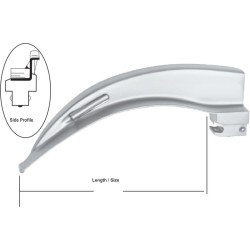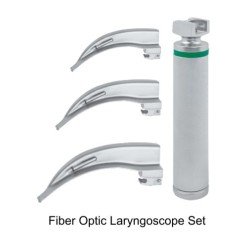Laryngoscopes are medical instruments used primarily in the field of otolaryngology (ear, nose, and throat) and anesthesiology. They are essential for visualizing the larynx (voice box) and facilitating procedures such as intubation. Here are some key points about laryngoscopes:
Purpose:
- Visualization: Laryngoscopes allow healthcare providers to view the larynx and surrounding structures, which is crucial for diagnosing conditions affecting the airway.
- Intubation: They are commonly used to assist in the placement of an endotracheal tube during anesthesia or in emergencies to secure the airway.
Types:
- Direct Laryngoscope: This type features a straight or curved blade that is inserted into the mouth to directly visualize the larynx. The most common example is the Miller or MacIntosh blade.
- Indirect Laryngoscope: This type uses a mirror or a video camera to visualize the larynx indirectly, often used in outpatient settings or for specific diagnostic purposes.
Design:
- Blade: The blade of a laryngoscope can be curved or straight, depending on the type and the specific needs of the procedure. The choice of blade affects the ease of visualization and intubation.
- Light Source: Most modern laryngoscopes are equipped with a light source (often LED) to illuminate the airway, enhancing visibility during the procedure.
Considerations:
- Technique: Proper technique is crucial to minimize trauma to the patient’s airway and to ensure successful intubation.
- Patient Comfort: Care should be taken to minimize discomfort and anxiety for the patient during the procedure.
- Sterilization: Laryngoscopes must be properly sterilized between uses to prevent infection.
If you have specific questions about laryngoscopes or their applications, feel free to ask!
Article #: PAD-22.00
McIntosh Laryngoscopes Set, with Standard illuminationSet of 3 blades No. 2,3,4Set of 5 blades No. 00, 0,1,2,3 (pediatric)Set of 4 blades No. 0,1,2,3 (pediatric..
$55.00
Article #: PAD-44.09
Macintosh Laryngoscope Blades with Fiber Optic Illumination.Interchangeable Fiber Optic Channels. Fiberoptic channels can be taken apart by unscrewing. They can..
$12.00
Article #: PAD-42.00
Macintosh Laryngoscope Set , with Fiber Optic illumination and Interchangeable Fiberoptic Channels.Set of 3 blades No. 2,3,4Set of 5 blades No. 00,0,1..
$60.00
Article #: PAD-42.20
McIntosh Laryngoscope Set, with Fiber Optic illumination With Integrated, Fiberoptic Channel. A- Set of 3 blades No. 2,3,4B- Set of 4 blades No. 0,1,2..
$60.00
Article #: PAD-22.50
Macintosh Laryngoscopes Set Standard Economy Model.McIntosh Set, with Standard illuminationEconomy ModelSet of 3 blades No. 2,3,4Set of 4 blades No. 1,2,3,4All ..
$55.00
Article #: PAD-24.09
McIntosh Laryngoscopes Blades with Standard Illumination.Smooth ShapeBright LightSecure connectionsMatt FinishStandard Specifications
Fig
Size
For
0045 ..
$9.90
Article #: PAD-28.00
Miller Set, with Standard IlluminationA- Set of 3 blades No. 1,2,3B- Set of 5 blades No. 00,0,1,2,3 (pediatric)C- Set of 4 blades No. 0,1,2,3 (pe..
$50.00
Article #: PAD-44.230
TeleTip Laryngoscope Set For Difficult Intubation. TeleTip is a MacIntosh Laryngoscope blade with an adjustable distal tip, which is controlled by a lever to li..
$230.00
Showing 1 to 8 of 8 (1 Pages)
Latest Posts
Gulmaher Surgico
0
In the
healthcare industry, having the right tools is crucial to ensure effective and
accurate treatment. From diagnostic instruments to specialized tools for
obstetrics and gynecology, various medical devices are integral to procedures
and patient care. This blog highlights some key instruments used in different
medical fields, including neuro-dia..
Gulmaher Surgico
0
When it
comes to performing delicate and precise surgeries, especially plastic
surgeries, having the right instruments is crucial. At GulmaherSurgico,
we pride ourselves on being a one-stop shop for all your surgical needs,
offering a wide variety of genuine surgical instruments at the lowest
prices. Whether you're a surgeon or a medical profession..
Gulmaher Surgico
0
In the world of modern medicine, plastic surgery instruments play a vital role in achieving
precision, safety, and aesthetic perfection. Whether it’s reconstructive or
cosmetic surgery, surgeons rely on specially designed surgical instruments to
ensure the best outcomes for their patients.What Are Plastic Surgery
Instruments?
Plastic surgery inst..
Gulmaher Surgico
0
In every
surgical procedure, precision, visibility, and control are extremely important.
To achieve this, surgeons rely on a wide range of gyno tools, surgicalretractors, and different types of surgery instruments designed for
specific tasks. Whether it'sgynecology, general surgery, plastic surgery, or
emergency care, proper instruments help improv..
Gulmaher Surgico
1
Gynecologist Tools:-There are many divisions within the field of women's health and delivery out of which one is understood as obstetrics-gynecology. Every field of ob gyne uses gynecologist tools; sometimes there are ob gyne instruments that are specific to the sector whereas sometimes, there are gyne instruments that are generally utilized i..











-300x225h.png)


-300x225h.png)
